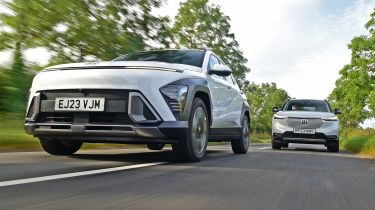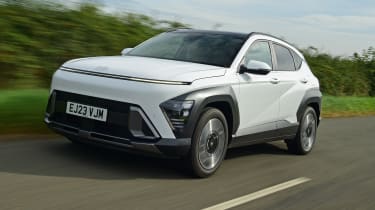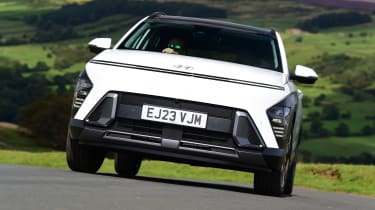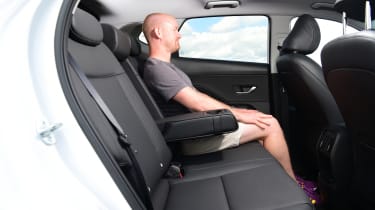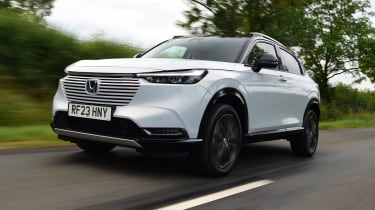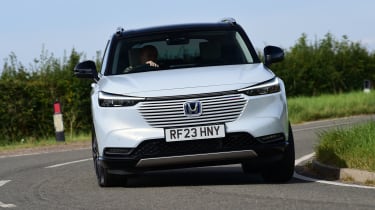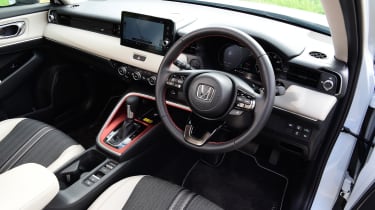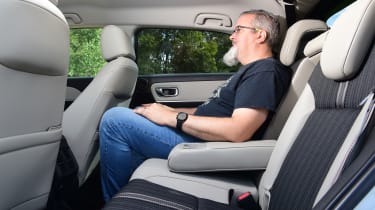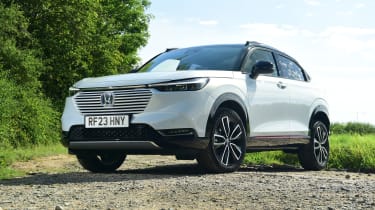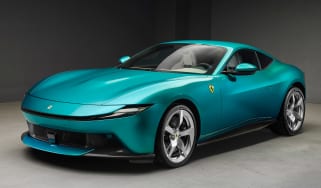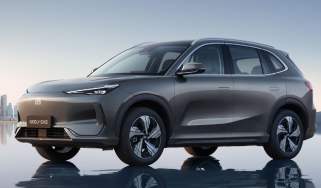Hyundai Kona vs Honda HR-V: hybrid SUVs battle for supremacy
Is the Hyundai Kona a strong contender in hybrid guise? We compare it with the Honda HR-V to find out
We’re big fans of the latest Hyundai Kona. The small SUV is our current Car of the Year, but our verdict was largely based on experience with the all-electric version. As with the previous-generation Kona, there are conventional petrol and hybrid models in the line-up, too – so is it still a compelling compact SUV when internal combustion is added to the mix?
To find out, we’re lining up the Kona Hybrid against a rival that delivers a lot more versatility than its predecessor did – the Honda HR-V. Both cars are similar in size, while hybrid drive means that they perform well at the pumps, too. But which is the one that we’d choose? Read on to find out.
| Hyundai Kona 1.6 GDi Hybrid Ultimate | Honda HR-V 1.5 i-MMD Advance Style | |
| Price: | £34,225 | £36,295 |
| Powertrain: | 1.6-litre 4cyl petrol hybrid, 139bhp | 1.5-litre 4cyl petrol hybrid, 129bhp |
| 0-62mph: | 11.2 seconds | 10.7 seconds |
| Test efficiency: | 58.4mpg/12.8mpl | 55.1mpg/12.1mpl |
| CO2: | 107g/km | 122g/km |
Hyundai Kona
The second-generation Hyundai Kona has picked up where the original version left off, with electric, petrol and hybrid options on offer. We’re testing the top-spec hybrid version here, which undercuts the high point of the Honda HR-V line-up on list price by just over £2,000.
Tech highlights
Hyundai redesigned the Kona from the ground up, and criticism about a shortage of space in the first generation doesn’t apply here. The new model uses the same platform as the Kia Niro, another model that comes with a choice of electric, hybrid or petrol power, and it’s biased towards electric drive over combustion engines.
Used - available now

2022 Volkswagen
ID.3
28,011 milesAutomaticElectric
Cash £15,300
2021 DS
DS 3 CROSSBACK
23,719 milesAutomaticPetrol1.2L
Cash £13,100
2021 Audi
A6
43,870 milesAutomaticPetrol2.0L
Cash £19,497
2023 Tesla
Model 3
30,362 milesAutomaticElectric
Cash £20,197The Kona features a 1.56kWh battery as part of its hybrid system, which is more than 60 per cent larger than the Honda’s battery, but it also features a smaller fuel tank, in preparation for the Kona to run on electric drive more frequently.
The powertrain is connected to a six-speed twin-clutch automatic gearbox, which goes against the hybrid norm; most rivals feature CVT-style single-speed transmissions. Drive is sent to the front wheels, and unlike the previous Kona, there is no four-wheel-drive version available.
Safety: Even the entry-level Kona features the kind of safety kit that you’d normally find in larger SUVs, with lane-keeping assist, intelligent speed-limit detection, rear-traffic monitoring and forward-collision avoidance among the safety tech highlights.
Unfortunately Hyundai’s systems are some of the most sensitive around, with constant warning beeps for even the slightest creep over the speed limit or movement out of lane. A button on the wheel deactivates lane assist, but the speed-limit warning is in a sub-menu, and it defaults to on every time you start the car.
On the road
Overactive warning beeps aside, the Kona is a relaxing small SUV that gets the job done.
Around town: Hybrids are at their best on urban streets, where electric drive does most of the work and the engine remains quiet even when pressed into action. It’s here that the Kona does its best work, with light steering, snappy low-speed responses and a relatively soft ride that means it’s comfortable.
Some of the safety kit has a tendency to over-react (lane assist will try and steer you back across a white line if you’re pulling wide to avoid a parked car, for example), but overall the Kona is perfectly at home in the city.
The paddles behind the steering wheel adjust the amount of energy recuperation you experience when slowing, although the two strongest settings activate the brake lights, which can make it look like you’re a nervous driver, rather than somebody who is trying to harvest energy.
A & B-roads: Increase your pace and there’s not much fun to be had, courtesy of steering that remains light and is devoid of feedback.
Harder acceleration sees the gearbox kick down to deliver soaring engine revs – not as high as the HR-V’s unit, but surprisingly harsh for a car equipped with a twin-clutch transmission.
Motorway: Once you’re up to speed, the engine settles back down to leave the cabin quiet and refined at higher speeds. At 70mph the Kona’s engine constantly runs, so the hybrid system isn’t at its most efficient. Activate the adaptive cruise control with steering assist and the system responds to other traffic well, while smoothly following the curve of the lane you’re in.
Ownership
The Kona has grown considerably with the arrival of this new model. It measures 18.5cm longer than the old car, is 2.5cm wider and has a wheelbase that’s been extended by 6cm, too. That means most of the issues with interior space that the old car suffered from have largely been addressed.
While there was nothing wrong with the layout of the old car’s cabin, the new Kona has been given a thorough makeover that’s inspired by the configuration of Hyundai’s electric Ioniq models. There’s still a decent array of buttons – including a bank of shortcut keys in the middle and a separate climate-control panel – but the layout has been simplified, while the twin digital screens give the Kona a hi-tech feel.
One difference between the hybrid model tested here and the all-electric Kona is that more dark materials are used in the combustion-engined car. Some of the plastics feel hard; Hyundai has tried to emulate metal for their finish, but it’s not a successful result.
Build quality is first rate, and it’s backed up by Hyundai’s familiar five-year, unlimited-mileage warranty. Honda’s cover is just for three years, although its 90,000-mile maximum distance could be attractive to high-mileage users.
Neither manufacturer was able to set the Driver Power charts alight, with Hyundai finishing 17th, one position ahead of Honda.
Storage: There’s plenty of space for odds and ends in the Kona’s cabin. There’s a wide and deep storage tray between the front seats that runs the length of the centre console, but rather than having an armrest bin behind it, there’s a moveable divider with the armrest set above it.
Pop-out cup-holders are located in this centre tray, while a smaller cubby further forward is big enough for a smartphone and contains a wireless charging pad. The glovebox isn’t the biggest around, but it’s supplemented by a shelf above.
Practicality
Fewer compromises are needed if you’re looking at the Kona as a family car.
Rear Space: The second-generation model’s longer wheelbase boosts cabin space, with more legroom than before. It’s not overly generous if taller occupants are sitting up front, but there won’t be as many complaints from the back seats.
The rear seatback has two positions, although the more upright setting is for the benefit of boot space. Rear air vents and USB connections are handy, while Ultimate models feature heated outer rear seats.
Boot: Another luxury of Ultimate trim is a powered tailgate that can be adjusted to open at different heights. Once opened, there’s a capacity of 466 litres to play with, which is bigger than the Honda’s space. There’s a level load lip, while folding the back seats leaves a bit of a step in the floor but creates 1,300 litres of space.
What to buy?
Which version we’d choose
- Powertrains: There’s just one system available in the Kona Hybrid. It uses a naturally aspirated version of the 1.6 GDi four-cylinder found in the petrol model, accompanied by a battery-powered electric motor. This is connected to a six-speed twin-clutch automatic gearbox that sends drive to the front wheels.
- Trim: The range kicks off with Advance trim, which is very well equipped for an entry-level model, while N Line has a sportier look. Next up is N Line S, which ramps up the kit, while Ultimate spec leaves you wanting for nothing when it comes to standard equipment.
- Our choice: While Ultimate has lots of kit, you won’t feel short-changed by N Line.
Honda HR-V
While there was a gap between the first and second-generation Honda HR-Vs, we didn’t have to wait for this Mk3 version. It’s the most advanced edition yet, and appropriately we’re testing the top-spec Advance Style model here.
It costs £36,295, which is £2,070 more than the top-spec Kona Ultimate we’re pitching it against.
Tech highlights
Under the skin of the HR-V is Honda’s Global Small Car platform, which it shares with the Jazz and a selection of Hondas sold in India and the Far East. However, the HR-V is far larger than the Jazz supermini, and has similar dimensions to its Kona rival here. The main difference is that the HR-V is a little narrower, but overall it’s still a neatly proportioned machine.
Drive comes from the same 1.5-litre i-MMD hybrid system that’s found in the Jazz, but power has been increased to cope with the HR-V’s size. There’s 129bhp on tap, which is 10bhp down on the Kona, while maximum torque of 253Nm is slightly behind the Hyundai’s 265Nm. Despite this, the HR-V is faster from 0-62mph, with a time of 10.7 seconds, which is half a second ahead of the Kona.
The HR-V uses a CVT-style gearbox that manages energy flow between the engine, electric motor, battery and wheels. It’s a more a familiar set-up for a hybrid, but Honda has included steps in the power delivery that emulate the behaviour of a regular auto in an effort to limit the harshness that is so often associated with this type of gearbox.
Safety: The HR-V earned a four-star Euro NCAP safety rating in 2022, while the Hyundai Kona earned the same score in 2023. In terms of percentages, the HR-V has slightly better results in all categories, apart from child-occupant protection. Both cars feature two sets of ISOFIX mounts.
On the road
Overall the HR-V is a relaxed and refined performer, as long as you don’t ask too much of the hybrid powertrain.
Around town: As with the Kona, the HR-V performs at its best at low speeds, where the electric motor handles most driving besides pulling away from a standstill. When the engine does cut in, it’s relatively refined, although you need to be progressive with the throttle to keep it that way.
Different levels of energy recovery are on offer when slowing, with D and B modes on offer, although neither setting offers as much resistance as the strongest mode in the Kona.
A & B-roads: Head for the open road and the HR-V has a sportier feel than the Kona. While it has 18-inch wheels like the Hyundai, it’s fitted with lower-profile tyres, so the ride is marginally firmer, but by no means harsh.
Grip is good, and the car’s chassis feels agile, although the body’s high centre of gravity precludes you from exploring the car’s limits. There are three drive modes, and they deliver a distinct change in character when switching between them. Sport mode sees the engine running at all times, and there’s a snappy throttle response. One downside is that harder acceleration introduces more engine noise as the gearbox sends the revs soaring.
Motorway: Those lower-profile tyres don’t have too much of an impact on road noise, while wind noise at motorway speeds is kept in check, so the HR-V feels refined at a motorway cruise. Uphill slopes will see the engine revs rise to maintain a constant pace, though. The Honda’s lane-assist system isn’t quite as intrusive as Hyundai’s set-up, and can be turned off via a steering-wheel button.
Ownership
Small SUVs such as these offer a taller driving position than the average supermini, so they provide a better view of the road ahead, as well as improving access to the cabin.
The Honda is easy to place on the road courtesy of the good view out, but some drivers might find that their favoured seating position obscures parts of the dashboard. We found that placing the steering wheel in a high position blanked off the fuel gauge located across the bottom of the digital dials, while the starter button is hidden behind the wheel, too.
The rest of the dashboard has a scattergun feel about its layout, with clusters of controls mounted in assorted positions and with no real logic to the arrangement. Different design elements, combined with the light-grey dashboard trim, add to the incoherent feel of the car’s cabin. Build quality is fine, though, and the HR-V feels like it will stand up to the rough and tumble of family life.
Our Driver Power survey puts these two manufacturers level pegging in terms of owner satisfaction. Hyundai placed 17th in our most recent survey, just one place ahead of Honda. However these mid-table results aren’t outstanding, especially when you consider that Hyundai’s sister brand Kia finished sixth in the same survey.
Storage: With the drive selector located on the centre console and not the steering column, as it is in the Kona, there isn’t as much space for storage in the Honda. It features two fixed cup-holders located next to the drive selector, while behind that is a conventional armrest with a storage bin beneath it, but it’s not very deep.
The front door pockets aren’t as generous as they are in the Hyundai, either, while back-seat passengers have to make do with bottle holders instead of the larger bins found in the Kona.
Practicality
Honda has taken the clever storage solutions from the Jazz supermini and upscaled them for the HR-V.
Rear Space: If you’re travelling two-up in the back, then there won’t be any complaints about the amount of space on offer. There’s plenty of legroom and a flat floor across the width of the back seat, although shoulder space isn’t quite as generous here as it is in the Hyundai.
There are rear air vents and USB sockets, while the seatback pockets have a smaller compartment for holding smartphones.
Boot: At 319 litres, the HR-V’s boot is well behind the 466-litre capacity of the Kona’s, while hidden storage under the floor adds 16 litres of space. The flip-up cinema seats in the rear turn the passenger area into useful extra storage, while folding them flat creates 1,289 litres of space, just 11 litres down on the Hyundai’s maximum.
What to buy?
Which version we’d choose
- Powertrains: As with the Kona Hybrid, there’s just one drive option for the HR-V, which is the petrol-electric 1.5 i-MMD set-up tested here.
- Trim: There are three specs available, with Elegance kicking off the range for £30,695, which is £670 more than the cheapest Kona Hybrid. It’s an extra £2,455 for Advance trim, while Advance Style is another £3,145 on top of that. Standard kit on both of these versions is generous, with the latter adding a contrast roof, light grey interior trim, active corner lighting and orange detailing inside and out.
- Our choice: We’d ditch the trinkets of Advance Style trim and pick Advance instead.
Results
Which car comes out on top?
Winner: Hyundai Kona
It’s a surprisingly close-run thing, but the Hyundai Kona narrowly gets ahead of the HR-V here. The additional space it has to offer, especially when compared with its predecessor, means it’s a much more viable family car than before. Add in great refinement and a comfortable ride, and it’s a winner.
Ultimate trim has all the kit you could possibly want and more, and it comes at a price that undercuts its rival here – although you could choose a lower-spec Kona and still not feel short-changed.
| Pros | Cons |
| Spacious interior | Too many warning beeps |
| Lots of safety kit | Lifeless steering |
| Refined powertrain | Some hard plastics in cabin |
| Comfortable ride | No centre armrest bin |
Runner-up: Honda HR-V
The HR-V is still an appealing small SUV, it’s just that the Kona betters it in some key areas. If you only need room for four, then it’s perfectly adequate, while the relative lack of boot space is made up for by the versatile rear seat system.
Neither car is particularly fun to drive, but if you like a bit of involvement, then the Honda is the better choice. And if you’re buying on finance, then the HR-V’s lower monthly outgoings and five years of servicing will be tempting.
| Pros | Cons |
| Clever rear seat system | Less cabin storage |
| Sporty handling | Smaller boot |
| Responsive powertrain | Fussier dashboard layout |
| Competitive finance rates | Harsh engine when revved |
Rivals and other options
The Kona wins our twin test, but what else is out there?
- Same class: Kia Niro
- Same money: Toyota C-HR
- Used: Mercedes GLE
- Used: Kia Sportage
- Coming soon: Volvo EX30
The great debate
What the Auto Express test team would do…
John Mcllroy, editor–at–large: “Look back a decade, and Hyundai was capable of building cars that were competitive with rivals, but couldn’t quite better them. Yet today the company is setting the standard in terms of design and tech, and the Kona’s transformation shows just how far the brand has come.”
Richard Ingram, deputy editor: “Switching to a hybrid car from a conventional petrol model is a good first step on the road towards full electrification. It helps buyers see the benefits of electric drive, but without the range or charging anxiety that still hangs over EVs. No wonder we’ve seen a rise in hybrid sales.”
Dawn Grant, picture editor: “The Kona is a distinctive-looking thing, and the LED lights are a standout. This top-spec Ultimate model features an LED strip that runs the full width of the nose, with a similar set-up at the rear. It gives the car a futuristic look, but thanks to the LED tech, there’s no compromise in vision at night.”
Steve Fowler, editor-in-chief: “The top-spec Kona has all the bells and whistles, but you can easily cut your monthly outgoings by choosing the N Line version instead. It features most of the kit you’ll find on the top-spec model, so you won’t feel short-changed, and it comes in at £444 a month on our finance terms.”
Alex Ingram, chief reviewer: “Honda’s hybrid tech always seems to be a step behind its rivals’ for efficiency. Just look at the HR-V’s CO2 emissions, for example. A figure of 122g/km puts the car in the 29-per cent company car tax bracket, which is three slots above its Hyundai rival here.”
Which would you buy? Let us know in the comments section below…
Specs and prices
| Hyundai Kona 1.6 GDi Hybrid Ultimate | Honda HR-V 1.5 i-MMD Advance Style | |
| On the road price/total as tested | £34,225/£34,550 | £36,295/£37,270 |
| Residual value (after 3yrs/36,000) | £18,858 (55.1%) | £18,148 (50.0%) |
| Depreciation | £15,367 | £18,148 |
| Annual tax liability std/higher rate | £1,767.74/£3,535.50 | £2,090.32/£4,180.60 |
| Annual fuel cost (12k/20k miles) | £1,308 (£2,180) | £1,386 (£2,310) |
| Ins. group/quote/VED | 18/£851/£170 | 31/£906/£170 |
| Cost of 1st/2nd/3rd service | £155/£280/£162 | £285/£355/£355 |
| Length/wheelbase | 4,350/2,660mm | 4,340/2,610mm |
| Height/width | 1,585/1,825mm | 1,582/1,790mm |
| Engine | 4cyl in-line/1,580cc | 4cyl in-line/1,498cc |
| Peak power/revs | 139bhp/5,700rpm | 129bhp/6,000rpm |
| Peak torque/revs | 265Nm/4,000rpm | 253Nm/4,500rpm |
| Transmission | 6spd auto/fwd | CVT auto/fwd |
| Fuel tank/battery capacity | 38 litres/1.56kWh | 40 litres/0.92kWh |
| Boot capacity (seats up/down) | 466/1,300 litres | 319/1,289 litres |
| Kerbweight/payload/towing weight | 1,410/540/1,300kg | 1,380/490kg/N/A |
| Turning circle/spare wheel | 10.6 metres/repair kit | 11.3 metres/repair kit |
| Basic warranty/recovery | 5yrs (unlimited)/1yr | 3yrs (90,000)/3yrs |
| Driver Power manufacturer/dealer position | 17th | 18th |
| Euro NCAP: Adult/child/ped./assist/stars | 80/83/64/60/4 (2023) | 82/75/72/78/4 (2022) |
| 0-62mph/top speed | 11.2 seconds/103mph | 10.7 seconds/106mph |
| Auto Express economy/range | 58.4/488 | 55.1/485 |
| WLTP combined | 60.1mpg | 52.3mpg |
| Actual/claimed CO2/tax bracket | 112/107g/km/26% | 118/112g/km/29% |
| Number of airbags/Isofix points | Seven/two | Six/two |
| Parking sensors/camera | Front & rear/yes | Front & rear/yes |
| Lane-keep assist/blindspot/AEB | Yes/yes/yes | Yes/yes/yes |
| Climate control/adaptive cruise | Two-zone/yes | Two-zone/yes |
| Leather/heated seats/wheel | Yes/front & rear/yes | Part synthetic/front/yes |
| Metallic paint/LED lights | £650/yes | £650/yes |
| Keyless entry & go/powered tailgate | Yes/yes | Yes/yes |
| Sat-nav/digital dashboard/USBs | Yes/yes/four | Yes/yes/four |
| Online services/wireless charging | Yes/yes | Yes/yes |
| Apple CarPlay/Android Auto | Wireless/wireless | Yes/yes |

